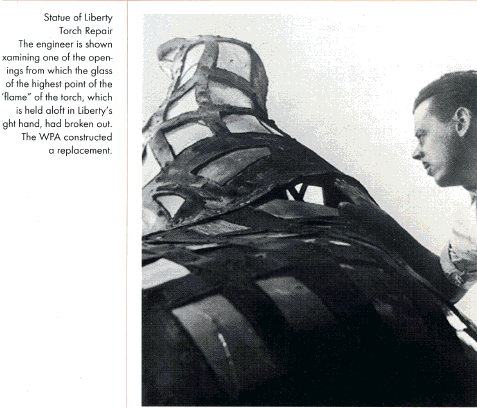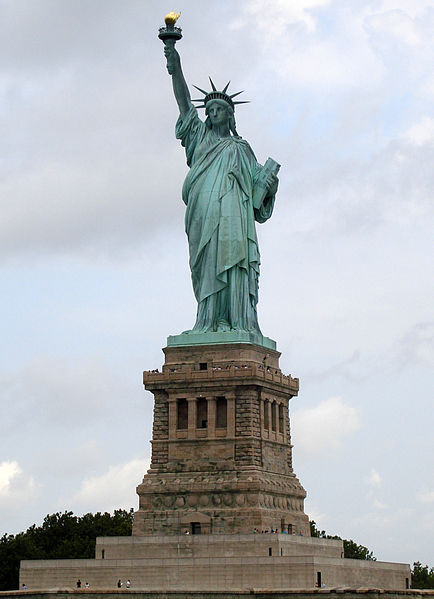- City:
- New York, New York City, NY
- Site Type:
- Civic Facilities, Parks and Recreation, Monuments and Memorials, Lodges, Ranger Stations and Visitor Centers, Paths and Trails
- New Deal Agencies:
- Works Progress Administration (WPA), Public Works Funding, Work Relief Programs, Public Works Administration (PWA)
- Started:
- 1938
- Completed:
- 1942
- Quality of Information:
- Very Good
- Site Survival:
- Extant
Description
The Statue of Liberty was a gift to the United States from France in 1886. It was administered by the United States Lighthouse Board until 1901 and then by the Department of War. In 1937, FDR proclaimed the entire island a National Monument administered by the National Park Service. From 1937-1941, the WPA and PWA carried out extensive renovations of the statue and Bedloe (now Liberty) island.
In his history of the Statue of Liberty, Berenson (2012) elaborates on the federal government’s role: “the NPS devised an ambitious plan to remove all structures save for the statue itself, shore up the island with a new seawall and landfill, build a new dock, add walkways around the monument, and finally repair or replace badly rusted parts of Liberty’s skeleton. The Park Service didn’t possess the $1.5 million needed to do this work, so it relied on New Deal institutions designed to alleviate unemployment and bolster the economy by dispatching people to public works projects. Between 1937 and 1941, the Public Works Administration (PWA) and Works Progress Administration (WPA) sent hundreds of laborers to Bedloe’s Island to fulfill the NPS’s plans. They removed Liberty’s rays one by one to clean out the rusted innards that threatened to collapse them into the sea; began work on the corroded, unsafe cast-iron stairway to the top of the pedestal; replaced the dangerous steps that led up to the statue’s base; sealed Liberty’s footings with a copper apron designed to keep seawater and rainwater out; remodeled the administration building; and built a visitor’s center.”
The WPA Guide to New York City further described the WPA’s role in landscaping all of Bedloe Island and “providing a more attractive approach to the statue.”
Ellis Island was added to the Statue of Liberty National Monument in 1965.
Source notes
The WPA Guide to New York City: The Federal Writers' Project Guide to 1930s New York. New York: Pantheon Books, 1982. 413. Berenson, E. (2012). The Statue of Liberty: A Transatlantic Story. Yale University Press.At this Location:
- Ellis Island: Ferry Building - New York NY
- Ellis Island: Recreation Building - New York NY
- Ellis Island: Recreation Shelter - New York NY
- Ellis Island: New Immigration Building - New York NY
- Ellis Island: Passageway C7 - New York NY
- Ellis Island: Passageway C8 - New York NY
View all sites at Statue of Liberty National Monument - New York NY (7 Sites)
Contribute to this Site
We welcome contributions of additional information on any New Deal site.
Submit More Information or Photographs for this New Deal Site







Join the Conversation